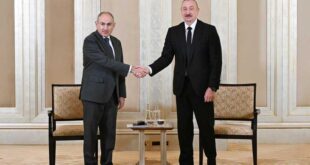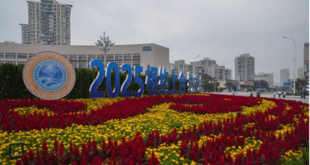By Shehab Al Makahleh
In a stunning turn of events, Hezbollah leader Hassan Nasrallah was assassinated in Haret Hreik, marking the most significant blow to the Lebanese militia since its inception. This assassination represents not just the loss of a charismatic leader but the unraveling of a complex power play orchestrated by Iran. For decades, Nasrallah was the face of Hezbollah, the spearhead of Iranian influence in Lebanon and the broader Middle East. His assassination, however, reveals a much deeper and darker reality: Iran’s decision to sacrifice its proxy for the sake of its own survival.
Reports emerged about two weeks ago, warning of imminent blows to Tehran from multiple directions. These threats, which could destabilize the Iranian regime and even fragment the country into smaller states, sent shockwaves through the corridors of power in Tehran. Facing an existential threat, the regime in Iran found itself at a historic crossroads. The solution it chose was as brutal as it was strategic—sacrificing its most visible and potent ally, Hezbollah, starting with the senior military and security leadership, and culminating with the assassination of Hassan Nasrallah.
This move by Tehran was not made lightly. A message was conveyed to the Iranian leadership, warning them that their aggressive policies had pushed too far, and that major international actors would no longer tolerate the expansion of Iranian influence through its proxies. Iran, in its desperation to avoid regime collapse, had to make a monumental concession. Nasrallah’s life was traded in a bid to pacify those powers that had become increasingly intolerant of Iran’s regional ambitions.
Nasrallah’s assassination is the final act in a tragic play that began with the systematic targeting of Hezbollah’s senior military and security leadership. Over recent years, key figures within the organization were either killed in covert operations or sidelined, signaling a larger strategic shift. It was clear that Hezbollah, once seen as an untouchable force backed by the full weight of the Iranian regime, had become expendable.
Nasrallah himself, revered as a hero by many in the Shia world, was ultimately left unprotected. His elimination, whether facilitated or directly orchestrated by Tehran, serves as a symbolic offering to the international community. Iran’s message is clear: “We are willing to sacrifice even our most valued assets if it means staving off further attacks on our regime.”
For the Iranian regime, Hezbollah has long been its sword and shield in Lebanon. Through Hezbollah, Tehran has exerted influence over the Levant, challenged Israeli and Western interests, and maintained a strategic foothold along the Mediterranean. But the regime is now cornered. Iran is facing economic sanctions, internal unrest, and regional isolation. The regime’s focus has shifted from exporting revolution to mere survival.
Nasrallah’s death, therefore, is not just a local event—it’s part of a broader Iranian strategy to reduce international pressure. Tehran, understanding that its nuclear program and regional destabilization policies were placing it at direct odds with global powers, made the cold calculation to sacrifice Nasrallah to stave off the complete dismantling of its regime.
The assassination of Hassan Nasrallah is a watershed moment for the Middle East. It is the clearest sign yet that Iran is no longer willing to support its proxies at all costs. Hezbollah, once Iran’s crown jewel, has been abandoned at its most critical hour, sending shockwaves throughout the region.
For Hezbollah, Nasrallah’s assassination could mark the beginning of the end. The organization, already facing declining support and increasing opposition within Lebanon due to its deep involvement in Syria and its role in Lebanon’s political paralysis, now finds itself leaderless. Without the unwavering support of Tehran and the presence of a charismatic figure like Nasrallah, Hezbollah may not be able to withstand the pressures that will inevitably follow his assassination.
Iran’s decision to sacrifice Hassan Nasrallah raises significant questions. Was this a strategic masterstroke to buy time, or a desperate act that will backfire? The assassination, while perhaps temporarily placating Iran’s adversaries, may embolden those same powers to push even harder against Tehran’s regional proxies. Iran’s decision to sacrifice Nasrallah could lead to Hezbollah’s collapse, thereby weakening Tehran’s influence in Lebanon and the wider region.
Furthermore, this move may not satisfy the international actors pushing against Iran. The powers that be may view this sacrifice as too little, too late, and continue to press for further concessions, including on Iran’s nuclear program and regional activities. Nasrallah’s death, therefore, may only serve as a temporary reprieve for a regime facing mounting existential threats.
Hassan Nasrallah’s assassination is not just the death of a leader—it’s the death knell for an entire strategy of Iranian expansionism. The Shia Crescent, which once seemed unstoppable, is now fraying at the edges. In Lebanon, Hezbollah will face increased pressure without its formidable leader, while Iran’s regional ambitions will be severely curtailed.
Iran’s decision to sacrifice Nasrallah may buy it some time, but at what cost? Tehran’s willingness to abandon its most loyal proxy signals a regime that is increasingly desperate. This may be the beginning of a new era in the Middle East, one in which Iran’s influence wanes, and its enemies, both within and outside the country, grow bolder.
Hassan Nasrallah’s assassination is not just a local tragedy—it is the culmination of decades of geopolitics, power struggles, and the ultimate realization that no one, not even a figure as iconic as Nasrallah, is immune from being sacrificed when the stakes are regime survival. Iran has played its hand, but the game is far from over.
The assassination of Hassan Nasrallah will undoubtedly reverberate across the Middle East, triggering shifts in regional power dynamics. Hezbollah has long been the linchpin of Iran’s strategy to project power and influence in Lebanon, Syria, and beyond. With Nasrallah gone, Hezbollah may struggle to maintain its grip on Lebanese politics, and Iran’s broader influence in the Levant will likely diminish. This weakening of Iran’s foothold could open the door for rival regional powers, such as Saudi Arabia and Israel, to assert themselves more aggressively in Lebanon and Syria. Saudi Arabia, which has been staunchly opposed to Hezbollah’s dominance in Lebanese politics, may see this moment as an opportunity to reassert its influence in Beirut, while Israel might feel emboldened to take bolder actions against Hezbollah’s military infrastructure in southern Lebanon without fear of immediate retaliation.
Moreover, Nasrallah’s death may alter the strategic calculus for Syria, where Hezbollah fighters have been instrumental in propping up the Syrian armed forces. The vacuum left by his assassination could weaken the coordination between Tehran, Hezbollah, and Damascus, potentially destabilizing the fragile balance of power in Syria. This development could lead to increased competition among regional actors like Turkey, Russia, and the Gulf states, all of whom have vested interests in shaping Syria’s future. As Hezbollah struggles to regroup, Iran’s ability to influence the outcome of conflicts and power struggles in both Lebanon and Syria may falter, creating new geopolitical opportunities and risks across the Middle East.
 Geostrategic Media Political Commentary, Analysis, Security, Defense
Geostrategic Media Political Commentary, Analysis, Security, Defense





